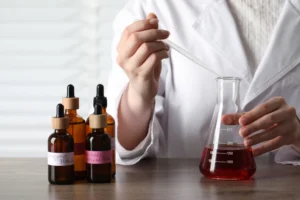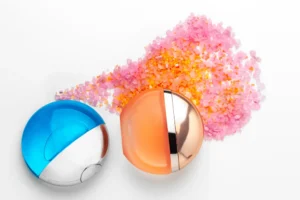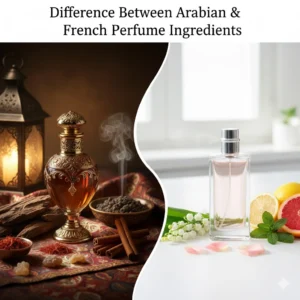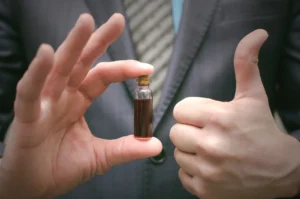To achieve a distinctive olfactory signature for your brand, one that meets market standards for excellence, you must first understand fragrance components and how they interact within the scent pyramid. This foundational knowledge is key to successfully evaluating fragrance samples, anticipating their performance, and projecting their commercial success.
Therefore, today’s Jasmine article will focus on the essential Perfume Ingredients, the difference between their application in Arabic and French perfumery, and how you can choose the most suitable scents for your store.
Read on.
What are the main components of perfume?
To build a successful perfume, you must know that its foundation is a masterful blend of concentrated aromatic oils, solvents, and fixatives—elements that work in unison to achieve scent longevity.
Fragrance Pyramid
Fragrance components are categorized within a hierarchical system, a division that determines the sequence in which scents appear and evaporate (or dissipate).
Top Notes
These are the first aromas to touch the sense of smell immediately upon spraying the fragrance. They consist of light, rapidly evaporating molecules. Their primary function is to create an appealing initial impression. They typically include citruses like bergamot or lemon, as well as mint or refreshing green/herbal scents. Their longevity is brief, lasting anywhere from a few minutes up to a maximum of fifteen minutes.
Middle Notes
These emerge immediately after the top layer fades, representing the core and main personality of the fragrance, which the customer experiences most of the time. These notes last for significantly longer hours and are usually composed of florals like jasmine and rose, in addition to warm fruits or spices such as cinnamon. They function as a crucial link between the quick opening and the heavy base.
Base Notes
These are the heaviest and longest-lasting scents, providing the fragrance with its depth and final tenacity. They include heavier elements such as musk, sandalwood, amber, vanilla, and patchouli, all of which have very slow evaporation rates. Their primary role is to anchor the fragrance to the skin and ensure the scent’s continuity for the longest possible duration, which can last for many hours or even days.
To secure fragrances with an ideal hierarchical balance and superior performance, contact Jasmine Factory now.
Also read: Original Perfumes: Ingredients, How to Differentiate from Fake

Men’s vs. Women’s Perfume Ingredients
You strongly sense this difference when sampling both types, as their chemical compositions vary significantly. Understanding this contrast is fundamental to offering a product that truly resonates with your customer.
Men’s Fragrance Components
These generally focus on power, longevity, and woody or sharp/earthy dimensions that convey depth and seriousness.
- Woods and Resins Materials like sandalwood and cedar are widely utilized to impart a classic, stable masculine touch to the fragrance’s base. Resins, such as frankincense (incense) and opoponax, provide a smoky or leathery dimension that deepens and enriches the scent structure.
- Leathery and Smoky Notes Scents that mimic tanned leather, tobacco, or birch are a core element in premium men’s fragrances. These components give the perfume a strong, luxurious character, suggesting depth and complexity in its composition.
- Lavender and Rosemary These strong aromatic herbs are an essential part of the classic Fougère fragrance category dedicated to men. These botanicals introduce a distinctly sharp, refreshing touch that breaks through the heaviness of woods and leather notes.
Women’s Fragrance Components
Their signature is suppleness, softness, and openness, with a greater focus on floral and sweet notes to create an attractive and alluring effect.
- White and Red Florals Jasmine, tuberose, and orange blossom are used heavily to lend a purely feminine scent and a rich layer to the perfume. Roses, in their various forms, are the queen of this category, adding a classic, romantic dimension to the overall composition.
- Vanilla and Gourmand Sweets Vanilla is a fundamental element of warmth and longevity in the base of women’s perfumes, imparting an Oriental or sweet character. Scents of caramel, almond, or chocolate are added to give a captivating hint of warmth and a modern gourmand dimension.
- Soft and Exotic Fruits Fruit notes like peach, berries, and pear are added to the top or middle notes to give the fragrance a vibrant, juicy quality and a refreshing opening. Pineapple or mango are integrated into advanced formulations to create a unique and innovative tropical character.
To ensure that every fragrance in your collection reflects the required specialization—whether masculine or feminine—start your partnership with Jasmine Perfumes and expertly design your formulations to guarantee distinction in the market.
Also read: Fl oz in Perfumes: Meaning and How it relates to Perfume Longevity

Arabic vs. French Fragrance Components
When you decide to focus on either an Arabic or a French fragrance, you must recognize that you are dealing with two entirely different philosophies of formulation and longevity. What, then, is the difference between these two types?
Arabic Fragrance Components
These feature a high concentration of natural oils and heavy components, which gives them a distinguished longevity and sillage (projection) that sets them apart from other global perfumes.
- Oud and Dehn Al Oud (Oud Oil) The most fundamental and valuable component in Arabic perfumery. It is known for its complex, woody, earthy scent that bestows a luxurious feel. It is used as a powerful base that anchors the fragrance for very long hours.
- Amber and Musk These are essential elements that lend a unique, sensual depth to the fragrance. These materials work to enhance the stability of other components and give the scent a captivating Oriental character.
- Warm Spices and Frankincense Saffron, cardamom, and cinnamon are frequently added to the middle notes to give the fragrance a rich, spicy character. Meanwhile, frankincense and myrrh imbue it with a spiritual dimension and a smoky depth that completes the Oriental composition.
French Fragrance Components
The focus here is on evolution and layering, utilizing lower concentrations of oils so that the scent is lighter and more refreshing.
- Citrus and Aldehydes French formulations rely on bergamot and grapefruit in the top notes to create a bright, fresh opening. Aldehydes, meanwhile, lend an impression of cleanliness and enable the rapid diffusion of the scent.
- Synthetic Florals Compounds such as white florals like lily of the valley and freesia are used, the synthesis of which allows for the creation of innovative floral notes that do not exist in nature, giving the perfume a sophisticated, modern characteristic.
- Light and Transparent Components Ozone scents, aquatic notes, and lightened patchouli are employed to deliver an impression of freshness, lightness, and transparency. This ensures the fragrance is not overpowering and is suitable for everyday wear.
Your specialization in Arabic and French perfumery demands a professional partner. Contact Jasmine now, and begin manufacturing your bespoke collection.
Also read: Everything About Alcohol-Based vs. Oil-Based Perfumes

How to Choose the Right Perfumes for Your Store or Brand?
To make the best selection, you must follow a strategic approach that achieves alignment between your product and your target audience.
Analyze the Fragrance Composition and Longevity Ratio
You need to assess the longevity of the fragrance and the quality of its core components to ensure customer satisfaction and minimize returns. Focusing on strong Base Notes is essential to achieve the staying power that consumers look for.
Understand Consumer Intent and Usage Occasions
Determine whether your customer is looking for a light daily fragrance for work (fresh scents) or a luxurious evening scent (heavy Oriental notes). Diversifying your products across these categories will cover all market needs and boost sales opportunities.
Monitor Current Fragrance Trends
You must track new releases and highly requested scents in the local and regional market to avoid selling outdated products. Focus on innovative aromas that meet consumer aspirations for novelty and distinction in the world of perfumery.
Study Competitive Pricing and Profit Margin
Compare the final cost price of the perfume, including shipping and customs clearance, with the prices of competitors in the local market to maintain your competitiveness. Selecting an appropriate price ensures good profitability without overpricing your product.
Evaluate Packaging and Presentation
Keep in mind that the bottle design, its durability, and the outer packaging are a primary part of the fragrance’s marketing value in the buyer’s eyes. Therefore, choose luxurious and attractive containers that convey the quality of the product and capture the customer’s attention.
At Jasmine Factory, we help you select the most suitable fragrances for your brand or store. Connect with our team; speak to them so we can begin our work.
Also read: Generic Perfumes: What is It & How to Start Your Own Line?

Jasmine Factory: Your Ideal Partner in the World of Perfumery
You and others are always seeking the best partner in the fragrance manufacturing business. Jasmine is a strong strategic partner, offering you our extensive and trusted expertise as a reputable perfume manufacturer in Turkey and globally.
Why Do Our Partners Trust Jasmine Factory?
- Accumulated Expertise in the Turkish Market: We possess a long track record of dealing with high-quality raw materials in Turkey and across regional markets.
- Commitment to Quality Standards (GMP): All our production processes strictly adhere to the highest internationally approved manufacturing specifications to ensure product safety and efficacy.
- Speed in Execution and Delivery: We utilize fast and efficient production lines that guarantee you receive your orders on the agreed-upon schedule without delays in completion and delivery.
- Professional Design and Packaging: We offer comprehensive services for designing bottles and packaging that reflect the luxury of your brand and attract a customer.
- Comprehensive Technical Support Service: We provide support at every step, from concept inception right through to the final product, which saves you time and effort.
Private Label Fragrance Design and Manufacturing for Your Brand
Manufacturing private-label fragrances is a key aspect of our work at Jasmine, and this will strengthen your market presence by:
- Developing Your Custom Fragrance Formulation: We provide you with a team of experts to assist in developing a unique fragrance formula that distinguishes you from competitors.
- Offering Suitable Minimum Order Quantities (MOQ): We provide flexible production volume options, allowing you to launch your project without the need for large, expensive minimum quantity orders.
- Using High-Purity Raw Materials: All oils and components we use in the manufacturing of your custom fragrances feature the highest standards of purity and quality.
- Custom Bottle and Packaging Design: We offer wide-ranging options for designing your bottles and outer packaging, giving your brand an attractive and personalized identity.
- Necessary Licensing and Permits: We take on the task of obtaining the required licenses and permits, saving you complex legal procedures.
To transform your brand idea into luxury fragrances ready for the market, contact us to manufacture your bespoke collection with the highest quality standards and artistic commitment.
FAQ about Perfume Ingredients
What material is perfume made of?
Perfumes are primarily made from a precise blend of concentrated aromatic oils, which are extracted from natural sources like plants or animals, or chemically synthesized in laboratories. These oils are dissolved in a solvent (usually high-purity ethyl alcohol) to facilitate diffusion and determine the final concentration ratio of the perfume.
What are the ingredients in pheromone perfume?
Pheromone perfumes consist of a traditional aromatic blend, such as woods or florals, to which a synthetic chemical compound is added to mimic natural human pheromones. The goal of this addition is to create a behavioral effect on others that enhances social or personal attraction.
What is the most popular ingredient in the global perfume?
White florals like jasmine and rose, along with sandalwood and oud (agarwood), are considered among the most famous components used in high-end global perfume formulations. These ingredients are used to provide the longevity, depth, and sensory value that consumers seek in international markets.
What are the best ingredients in perfume?
The best fragrance components are usually classified as those rare, high-purity natural ingredients, such as natural ambergris, Cambodian oud, or certain rare florals. The quality of the ingredients determines the perfume’s longevity and sillage (projection), which in turn reflects the market value of the final product.
What are fragrance notes?
Fragrance notes are the terms used to describe the individual scents that make up a perfume; they represent the sensory elements of the aroma. These notes are classified into different categories to illustrate the perfume’s composition and the character it expresses.
What are the different types of fragrance notes?
Fragrance notes are divided into three main types that form the scent pyramid: the Top Notes (the fast opening), the Heart Notes (the core of the scent and its medium-term longevity), and the Base Notes (the heavy, long-lasting aromas).